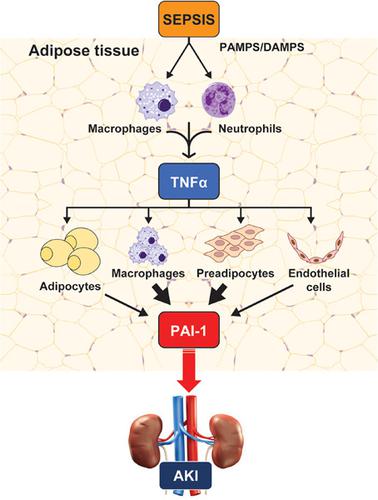当前位置:
X-MOL 学术
›
J. Cell. Physiol.
›
论文详情
Our official English website, www.x-mol.net, welcomes your feedback! (Note: you will need to create a separate account there.)
Visceral fat-specific regulation of plasminogen activator inhibitor-1 in aged septic mice
Journal of Cellular Physiology ( IF 5.6 ) Pub Date : 2021-08-09 , DOI: 10.1002/jcp.30551 Maria E C Bruno 1, 2 , Sujata Mukherjee 1, 3 , Arnold J Stromberg 4 , Hiroshi Saito 1, 2, 3, 5 , Marlene E Starr 1, 2, 3
Journal of Cellular Physiology ( IF 5.6 ) Pub Date : 2021-08-09 , DOI: 10.1002/jcp.30551 Maria E C Bruno 1, 2 , Sujata Mukherjee 1, 3 , Arnold J Stromberg 4 , Hiroshi Saito 1, 2, 3, 5 , Marlene E Starr 1, 2, 3
Affiliation

|
Elevated plasma levels of plasminogen activator inhibitor-1 (PAI-1) are documented in patients with sepsis and levels positively correlate with disease severity and mortality. Our previous work demonstrated that visceral adipose tissues (VAT) are a major source of PAI-1, especially in the aged (murine endotoxemia), that circulating PAI-1 protein levels match the trajectory of PAI-1 transcript levels in VAT (clinical sepsis), and that PAI-1 in both VAT and plasma are positively associated with acute kidney injury (AKI) in septic patients. In the current study utilizing preclinical sepsis models, PAI-1 tissue distribution was examined and cellular sources, as well as mechanisms mediating PAI-1 induction in VAT, were identified. In aged mice with sepsis, PAI-1 gene expression was significantly higher in VAT than in other major organs. VAT PAI-1 gene expression correlated with PAI-1 protein levels in both VAT and plasma. Moreover, VAT and plasma levels of PAI-1 were positively associated with AKI markers, modeling our previous clinical data. Using explant cultures of VAT, we determined that PAI-1 is secreted robustly in response to recombinant transforming growth factor β (TGFβ) and tumor necrosis factor α (TNFα) treatment; however, neutralization was effective only for TNFα indicating that TGFβ is not an endogenous modulator of PAI-1. Within VAT, TNFα was localized to neutrophils and macrophages. PAI-1 protein levels were fourfold higher in stromal vascular fraction (SVF) cells compared with mature adipocytes, and among SVF cells, both immune and nonimmune compartments expressed PAI-1 in a similar fashion. PAI-1 was localized predominantly to macrophages within the immune compartment and preadipocytes and endothelial cells within the nonimmune compartment. Collectively, these results indicate that induction and secretion of PAI-1 from VAT is facilitated by a complex interaction among immune and nonimmune cells. As circulating PAI-1 contributes to AKI in sepsis, understanding PAI-1 regulation in VAT could yield novel strategies for reducing systemic consequences of PAI-1 overproduction.
中文翻译:

老年脓毒症小鼠纤溶酶原激活物抑制剂-1 的内脏脂肪特异性调节
脓毒症患者血浆中纤溶酶原激活物抑制剂-1 (PAI-1) 水平升高,并且水平与疾病严重程度和死亡率呈正相关。我们之前的工作表明,内脏脂肪组织 (VAT) 是 PAI-1 的主要来源,尤其是在老年人(小鼠内毒素血症)中,循环 PAI-1 蛋白水平与 VAT 中 PAI-1 转录物水平的轨迹相匹配(临床脓毒症) ),并且 VAT 和血浆中的 PAI-1 与脓毒症患者的急性肾损伤 (AKI) 呈正相关。在当前利用临床前脓毒症模型的研究中,检查了 PAI-1 组织分布并确定了细胞来源以及介导 PAI-1 在 VAT 中诱导的机制。在患有败血症的老年小鼠中,PAI-1 基因在 VAT 中的表达明显高于其他主要器官。增值税 PAI-1 基因表达与增值税和血浆中的 PAI-1 蛋白水平相关。此外,PAI-1 的增值税和血浆水平与 AKI 标志物呈正相关,模拟了我们之前的临床数据。使用 VAT 的外植体培养物,我们确定 PAI-1 对重组转化生长因子 β (TGFβ) 和肿瘤坏死因子 α (TNFα) 治疗有强烈的反应;然而,中和仅对 TNFα 有效,表明 TGFβ 不是 PAI-1 的内源性调节剂。在 VAT 内,TNFα 定位于中性粒细胞和巨噬细胞。与成熟脂肪细胞相比,基质血管部分 (SVF) 细胞中的 PAI-1 蛋白水平高四倍,并且在 SVF 细胞中,免疫和非免疫区室都以类似的方式表达 PAI-1。PAI-1 主要定位于免疫区内的巨噬细胞和非免疫区内的前脂肪细胞和内皮细胞。总的来说,这些结果表明,免疫细胞和非免疫细胞之间复杂的相互作用促进了 PAI-1 从 VAT 的诱导和分泌。由于循环 PAI-1 会导致脓毒症中的 AKI,了解 VAT 中的 PAI-1 调节可能会产生新的策略来减少 PAI-1 过量产生的系统性后果。
更新日期:2021-08-09
中文翻译:

老年脓毒症小鼠纤溶酶原激活物抑制剂-1 的内脏脂肪特异性调节
脓毒症患者血浆中纤溶酶原激活物抑制剂-1 (PAI-1) 水平升高,并且水平与疾病严重程度和死亡率呈正相关。我们之前的工作表明,内脏脂肪组织 (VAT) 是 PAI-1 的主要来源,尤其是在老年人(小鼠内毒素血症)中,循环 PAI-1 蛋白水平与 VAT 中 PAI-1 转录物水平的轨迹相匹配(临床脓毒症) ),并且 VAT 和血浆中的 PAI-1 与脓毒症患者的急性肾损伤 (AKI) 呈正相关。在当前利用临床前脓毒症模型的研究中,检查了 PAI-1 组织分布并确定了细胞来源以及介导 PAI-1 在 VAT 中诱导的机制。在患有败血症的老年小鼠中,PAI-1 基因在 VAT 中的表达明显高于其他主要器官。增值税 PAI-1 基因表达与增值税和血浆中的 PAI-1 蛋白水平相关。此外,PAI-1 的增值税和血浆水平与 AKI 标志物呈正相关,模拟了我们之前的临床数据。使用 VAT 的外植体培养物,我们确定 PAI-1 对重组转化生长因子 β (TGFβ) 和肿瘤坏死因子 α (TNFα) 治疗有强烈的反应;然而,中和仅对 TNFα 有效,表明 TGFβ 不是 PAI-1 的内源性调节剂。在 VAT 内,TNFα 定位于中性粒细胞和巨噬细胞。与成熟脂肪细胞相比,基质血管部分 (SVF) 细胞中的 PAI-1 蛋白水平高四倍,并且在 SVF 细胞中,免疫和非免疫区室都以类似的方式表达 PAI-1。PAI-1 主要定位于免疫区内的巨噬细胞和非免疫区内的前脂肪细胞和内皮细胞。总的来说,这些结果表明,免疫细胞和非免疫细胞之间复杂的相互作用促进了 PAI-1 从 VAT 的诱导和分泌。由于循环 PAI-1 会导致脓毒症中的 AKI,了解 VAT 中的 PAI-1 调节可能会产生新的策略来减少 PAI-1 过量产生的系统性后果。



























 京公网安备 11010802027423号
京公网安备 11010802027423号